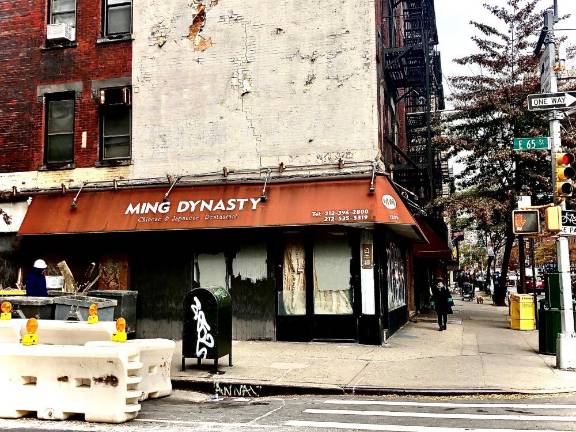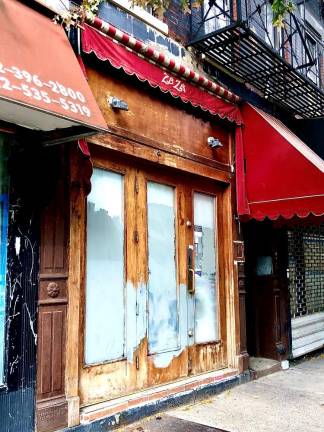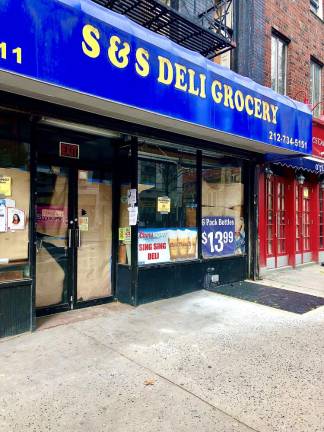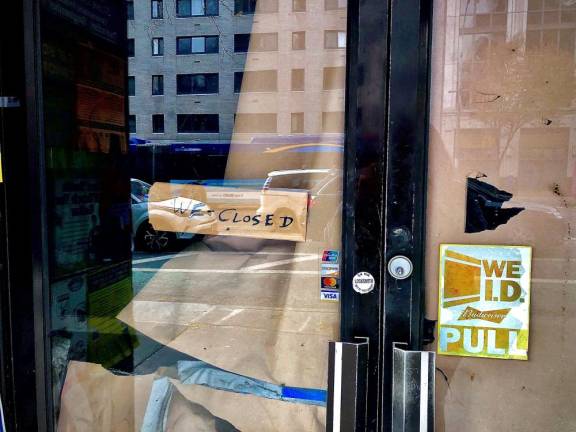Ghost Block on First Avenue
Once bustling streets on the UES are a distressing sign of developers' blight




On the west side of First Avenue between 65th and 66th streets, an Irish pub, a nail salon, a Chinese-Japanese fusion restaurant, a bodega, a trattoria, a discount grocer and a yarn store have all closed. They’re boarded up, glass windows painted gray, marked with graffiti or lined with brown paper. Inside, trash and merchandise have been left behind. Yellow signs warn pedestrians of rat bait. The apartments above are vacant.
It’s unclear for how long these spaces have been empty, and it’s unclear for how long they will remain that way. Applications to demolish the three buildings at 1209, 1211 and 1213 First Avenue were submitted to the Department of Buildings at the end of September. The buildings will likely be torn down and something new will be built on the lot — though without a proposal for specific development plans, the timeline of any project is blurry and certainly protracted.
It will take several forms — a stretch of vacant storefronts, a pile of rubble, a shroud of green scaffolding — but it will always be a developer’s blight.
“That’s happening on a lot of blocks across the Upper East Side,” said Paul Higgins, who co-chairs the small business committee for Community Board 8. He pointed to stretches in the 70s and 80s on First and Third avenues that have been similarly transformed from once-bustling areas into ghost blocks.
“It is a loss to the community,” said Higgins, who lives in the east 60s. “It is loss of storefront space, which is a detriment to the community from the perspective of — No. 1, just the lack of additional options whether it be restaurants or a mom and pop retail establishment.”
Safety Issue
Alida Camp, who sits on the zoning and development committee of CB8, said it’s common for business owners to warehouse their spaces and move their restaurant or store to a new location if they believe their landlords are going to sell the property, which prolongs the time the storefronts will be vacant.
“Everyone gets thrown out because they're selling it or there's going to be a development — even before things happen,” said Camp. “So that also creates an environment where businesses are moving out.”
She added that the empty spaces and construction area are not only aesthetically grim, but they also present a safety issue.
“It’s not safe because it's dark and the storefronts are not lit,” said Camp. “And so the sidewalks are dark and then it presents a somewhat oppressive atmosphere where it looks dour and it feels dour.”
More Development to Come
She said the lots have caused issues with delivery services, like Amazon, which have started using the areas to stop and sort packages and tie carts to bicycle racks.
“I think that would only be encouraged by having boarded up buildings because no one's going to complain,” she said. “The stores aren't going to complain that they're interfering with traffic or pedestrians or the image of the store.”
But for Camp, the blight is not a sign that the neighborhood is going downhill. It’s more a sign of development to come, which doesn’t make her happy either.
She’s concerned about losing affordable housing units when walkups are replaced by expensive condos, as well as the displacement of small businesses.
“The builders, the owners, they don't really care about — in many cases — about preserving small business,” she said. “So they're happy enough to rent a large space to a bank, a drug store.”
Camp added that losing small businesses means losing what make the different neighborhoods different.
“It's a shame in these towers are all the same; you go to Chelsea and Sixth Avenue and it's BestBuy and it's TJ Maxx. You go up to 61st Street and First Avenue and it's Best Buy. You can't tell where you are anymore.”
Small Business Challenges
Higgins and Camp want the city to do more to protect small businesses and affordable housing, and keep them from turning into developer’s blight.
Higgins said the city could be doing more to support the business by providing more help with commercial rent or providing tax breaks. Recently, Higgins and CB8 community members canvassed the neighborhood in Carnegie Hill to ask small business owners about their challenges. The most significant challenge identified in the survey was that they would face rent increases in the next year. Sixty-one percent of those surveyed said the city could better support businesses by helping to reduce the cost of commercial rent.
Camp said she doesn’t know exactly what policy should be put in place to end the trend of vacant city blocks waiting for development, but she said she thinks there’s a lot the city could be doing that they’re not doing.
“There's a lot of a lot of advantages given into big developers and not so many given into the small businesses, the rent regulated tenants, the preservation groups who care about the neighborhood,” she said, adding that there needs to be an aggressive campaign to keep businesses and residents where they are.
Otherwise, she said, New Yorkers will lose the heart of the city.
“It takes something that was charming, that was vibrant, that had businesses and, you know, people hanging around outside ... to something where people can’t wait to get off the street.”
“It takes something that was charming, that was vibrant, that had businesses ... to something where people can’t wait to get off the street.” Alida Camp of CB8